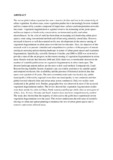Please use this identifier to cite or link to this item:
https://cris.library.msu.ac.zw//handle/11408/4124| Title: | Advancements in the remote sensing of landscape pattern of urban green spaces and vegetation fragmentation | Authors: | Kowe, Pedzisai Mutanga, Onisimo Dube, Timothy |
Keywords: | Remote sensing Landscape pattern Urban green spaces Vegetation fragmentation |
Issue Date: | 2021 | Publisher: | Taylor and Francis | Series/Report no.: | International Journal of Remote Sensing, Vol. 42; No. 10: p. 3797-3832; | Abstract: | The recent global urban expansion has seen a massive decline and loss in the connectivity of urban vegetation. In urban areas, some vegetation patches have increasingly become isolated and less connected by a matrix composed of impervious surfaces and transportation networks like roads. Vegetation fragmentation is a global threat to the remaining urban green spaces and has an impact on biodiversity conservation, environmental quality and urban microclimates. So far, a lot of work has been done on mapping and monitoring urban green spaces, some using conventional methods and of late using remotely sensed data. However, not much is known or well documented on the new developments in the remote sensing of vegetation fragmentation in urban areas over the last two decades. Thus, the objective of this research work is to present a detailed and comprehensive synthesis of the progress of remote sensing in assessing and monitoring landscape structure of urban green spaces and vegetation fragmentation. Specifically, scientific literature from the year 2000 to 2020 was reviewed to provide a state-of-the-art progress on the remote sensing of vegetation fragmentation in urban areas. Results indicate that between 2000 and 2020, there was a considerable increase in the number of scientific publications on vegetation fragmentation in urban landscapes. The discrete landscape pattern indices are the most widely used method. Comparatively, Land Remote Sensing Satellite System (Landsat) data was widely used due to its suitable spatial and temporal resolution, free availability and the presence of historical archival data that spans over a period of 40 years. The most commonly used scale was local (a city and/or municipality) followed by regional (more than one municipality in one continent) and then global (several selected cities and urban areas across continents). Only two studies were conducted at the global level. Further, geographic bias was observed in most of the accessed vegetation fragmentation studies. The review showed that vegetation fragmentation studies were done mostly for cities in China, North America and Europe while cities in most parts of Africa, Asia, Eurasia, Oceania and South America have not been comprehensively studied. The study also showed that the majority of cities across the globe have experienced severe vegetation fragmenta tion over the years. This review underscores the relevance of specific findings in urban and spatial planning to minimize the loss of urban green spaces and to conserve and restore affected areas. | URI: | https://www.researchgate.net/publication/349339224_Advancements_in_the_remote_sensing_of_landscape_pattern_of_urban_green_spaces_and_vegetation_fragmentation/link/602b9edea6fdcc37a82c5a75/download http://hdl.handle.net/11408/4124 |
ISSN: | 0143-1161 |
| Appears in Collections: | Research Papers |
Show full item record
Page view(s)
26
checked on Jul 25, 2024
Download(s)
18
checked on Jul 25, 2024
Google ScholarTM
Check
Items in MSUIR are protected by copyright, with all rights reserved, unless otherwise indicated.




